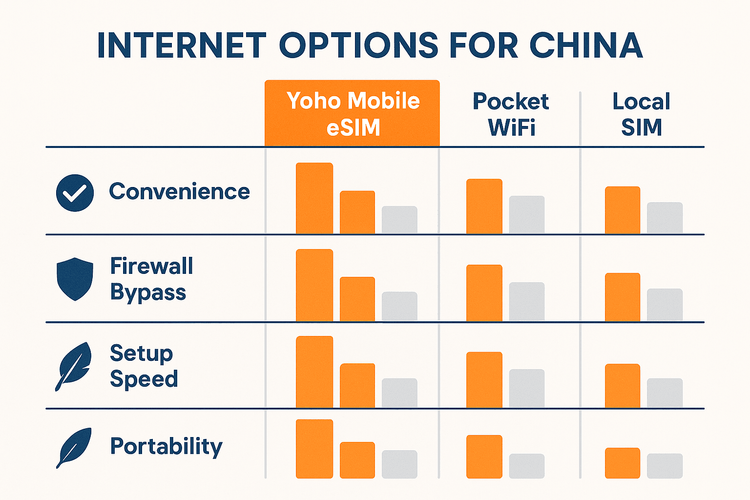China Internet Options: eSIM vs. Pocket WiFi & Local SIM | Yoho
Luis Rafael•Nov 03, 2025
Planning a trip to China is an exciting adventure, filled with ancient wonders and futuristic cities. But for the modern traveler, one question looms large: How will I stay connected? Navigating the internet in China presents unique challenges, most notably the “Great Firewall.” Choosing the wrong internet solution can leave you disconnected from familiar apps like Google Maps, Instagram, and WhatsApp.
This guide provides an authoritative comparison of the three main options for China travel internet: the modern eSIM, the traditional Pocket WiFi, and a local SIM card. We’ll break down the pros and cons of each, so you can make the best choice for a seamless and connected journey. Ready to get started? Explore Yoho Mobile’s eSIM plans for China today and connect the moment you land.

The Modern Choice: Yoho Mobile eSIM for China
An eSIM (embedded SIM) is a digital SIM card that allows you to activate a cellular plan without needing a physical nano-SIM. For travelers, this means you can purchase and set up a data plan for China before you even leave home.
Why an eSIM is Your Best Bet
Pros:
- Unbeatable Convenience: Purchase your plan online and activate it instantly upon arrival. For iOS users, the process is even simpler: after purchase, just tap the ‘Install’ button in the Yoho Mobile app to begin the 1-minute setup—no QR codes or manual activation codes needed. For Android, a simple QR code scan is all it takes.
- Bypass the Great Firewall: This is the game-changer. Yoho Mobile’s travel eSIMs route your data through international networks, granting you unrestricted access to the global internet. This means you can use Google, Facebook, WhatsApp, and all your favorite apps without needing a separate, often unreliable, VPN.
- Cost-Effective: Pay only for the data and duration you need. Our flexible plans are designed for travelers, saving you from expensive roaming charges from your home carrier.
- Keep Your Home Number: Because the eSIM handles your data, your primary physical SIM slot remains free. You can still receive calls and texts on your regular number while using the eSIM for affordable data.
Cons:
- Device Compatibility: eSIM technology is standard in most new smartphones, but older models may not support it. Be sure to check our constantly updated eSIM compatible device list before you buy.
With Yoho Mobile, you’re also covered by Yoho Care, our commitment to keeping you connected. Even if you run out of data, we ensure you have backup access so you’re never truly offline.
The Traditional Option: Pocket WiFi
A Pocket WiFi is a small, portable device that functions as a mobile hotspot. You rent it for the duration of your trip and connect your devices to its Wi-Fi signal.
Is Pocket WiFi Still Relevant?
Pros:
- Connect Multiple Devices: A single Pocket WiFi can provide internet for your phone, laptop, and a travel companion’s device simultaneously.
Cons:
- Bulky and Inconvenient: It’s another gadget to carry, charge every night, and worry about losing. If the device is lost or damaged, the rental company will charge a hefty fee.
- Logistical Hassle: You must arrange to pick up the device at the airport (often involving long queues) and remember to return it before your departure.
- Firewall Uncertainty: Many Pocket WiFi services offered within China use local networks, meaning they are often subject to the Great Firewall’s restrictions, defeating a key purpose for many travelers.

The Local Approach: Buying a China SIM Card
Purchasing a local SIM card upon arrival is another common method for getting connected. You can find them at airport kiosks or mobile carrier stores in the city.
The Reality of a Local SIM
Pros:
- Local Phone Number: It usually comes with a local Chinese phone number, which can be useful in specific situations.
- Potentially Cheaper for Very Long Stays: If you are staying for several months, a local plan might be more economical.
Cons:
- Difficult Purchase Process: The process requires your passport for registration, and you’ll likely face a language barrier. This can be a stressful first task after a long flight.
- Blocked by the Great Firewall: A local Chinese SIM card will give you local internet, meaning access to the global internet is heavily restricted. You will absolutely need a reliable VPN to use services like Google Maps or communicate via WhatsApp.
- Inconvenient: You have to physically swap out your home SIM card, risking losing it, and you won’t be able to receive calls or texts on your regular number unless you have a dual-SIM phone.
Head-to-Head: Which China Internet Option Wins?
To make the decision easier, here’s a direct comparison of the key factors for travelers.
| Feature | Yoho Mobile eSIM | Pocket WiFi | Local SIM Card |
|---|---|---|---|
| Convenience | ⭐⭐⭐⭐⭐ (Instant, digital setup) | ⭐⭐ (Pickup/return required, extra device) | ⭐⭐ (Airport queues, passport registration) |
| Firewall Bypass | ⭐⭐⭐⭐⭐ (Built-in, unrestricted access) | ⭐⭐ (Often blocked, depends on provider) | ⭐ (Blocked, requires a separate VPN) |
| Setup Speed | ⭐⭐⭐⭐⭐ (Under 1 minute) | ⭐⭐⭐ (After pickup, connect devices) | ⭐⭐ (Can take 30+ minutes at the store) |
| Cost | ⭐⭐⭐⭐ (Flexible, affordable travel plans) | ⭐⭐⭐ (Daily rental fees + risk of loss fees) | ⭐⭐⭐ (Plan cost + required VPN subscription) |
| Portability | ⭐⭐⭐⭐⭐ (Built into your phone) | ⭐⭐ (Another device to carry and charge) | ⭐⭐⭐⭐ (Inside your phone) |

Frequently Asked Questions (FAQ)
Do I need a VPN with a travel eSIM in China?
With a high-quality travel eSIM like those from Yoho Mobile, you do not need a separate VPN. Our service is designed for travelers and automatically routes your data to bypass the Great Firewall, giving you direct access to the global internet. This is a significant advantage over local SIMs and some Pocket WiFi options.
What is the best internet for a short trip to China?
For short trips (from a few days to a few weeks), an eSIM is undoubtedly the best option. It offers the perfect balance of convenience, cost, and, most importantly, unrestricted internet access. You can get a plan like a China 5GB 7 Days plan and be online moments after landing.
Can I use WhatsApp and Google Maps in China with a travel eSIM?
Yes! Because a Yoho Mobile eSIM bypasses the Great Firewall, you can use WhatsApp, Google Maps, Instagram, Gmail, and all your essential apps just like you would at home. This is a crucial feature for navigating cities and staying in touch with family.
How do I check if my phone is compatible with a China eSIM?
You can easily verify if your phone is eSIM-ready by checking our comprehensive eSIM compatible device list. Most smartphones released in the last few years from Apple, Samsung, and Google are compatible.
Conclusion: The Smartest Way to Stay Connected in China
While Pocket WiFi and local SIM cards were once the go-to options, modern technology has provided a far superior solution for travelers to China. An eSIM offers unparalleled convenience, eliminates the logistical nightmares of rental devices, and most critically, solves the Great Firewall problem right out of the box.
For a stress-free, connected, and unrestricted experience, Yoho Mobile’s eSIM for China is the clear winner. You get instant connectivity, the freedom of the open internet, and the peace of mind of Yoho Care.
Don’t let connectivity be a worry on your China trip. Try our service risk-free with a free trial eSIM or browse our flexible China eSIM plans today and travel smarter!
